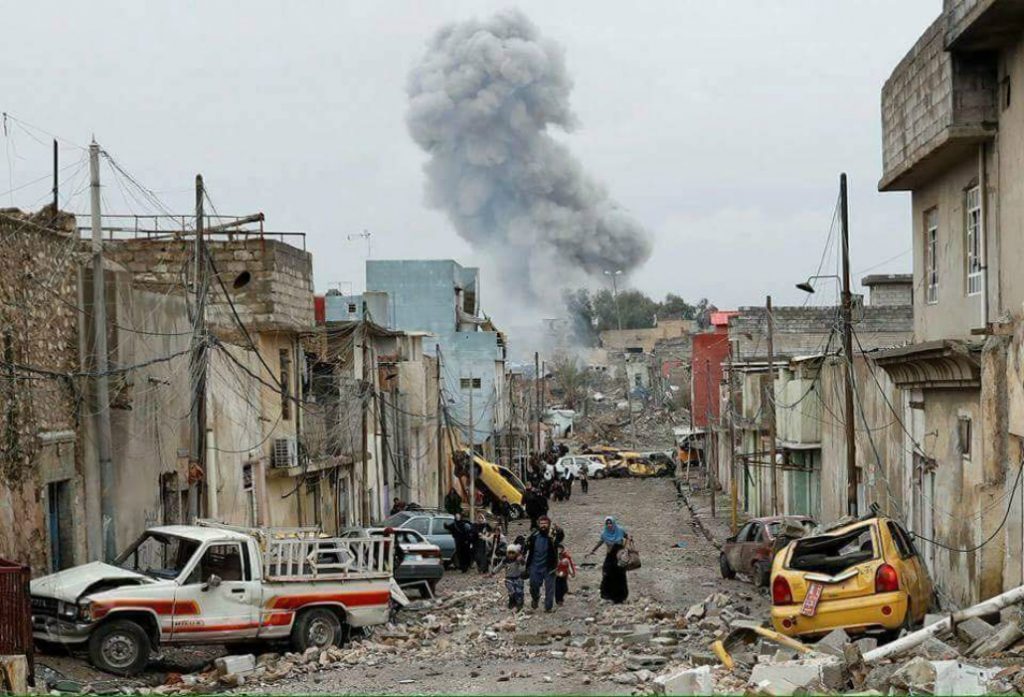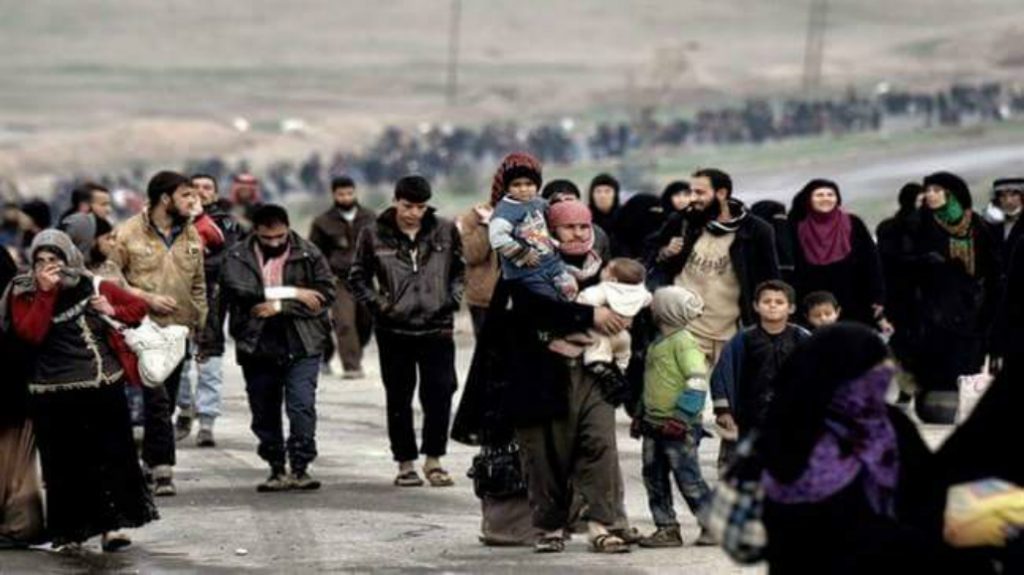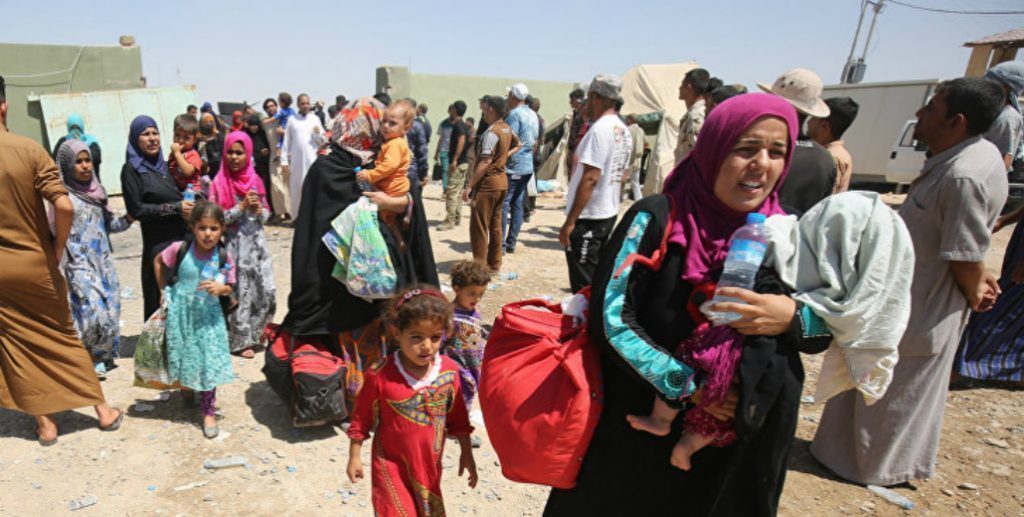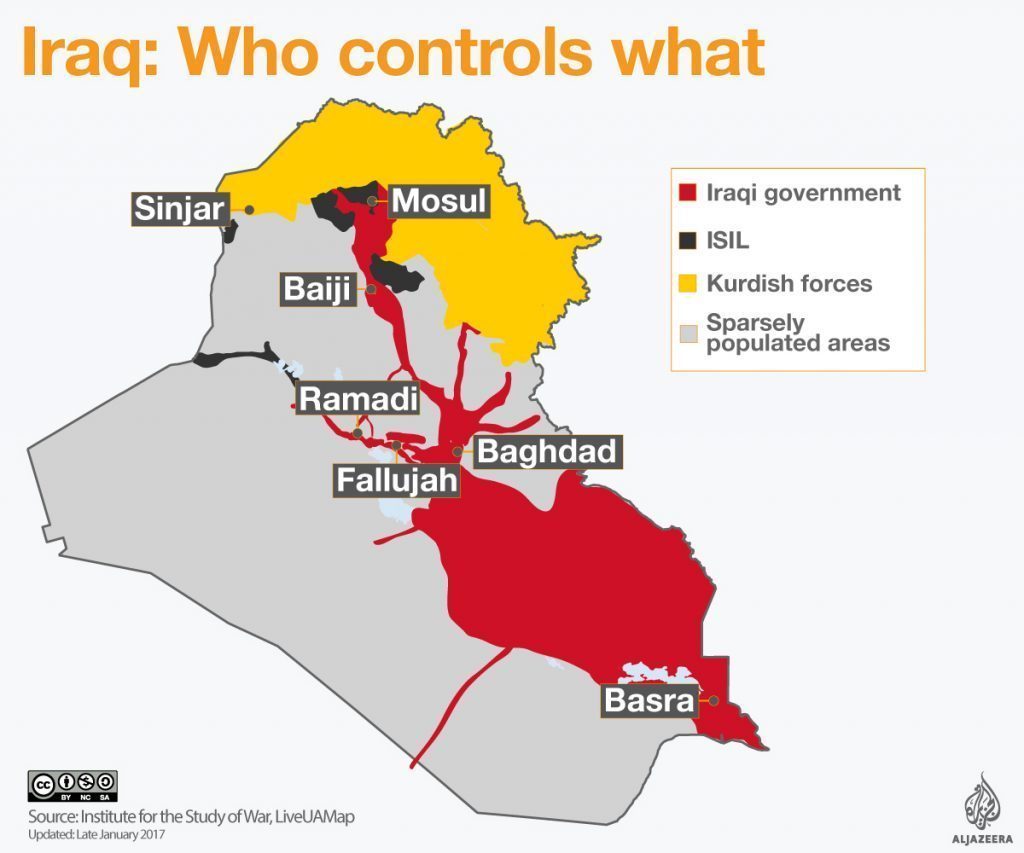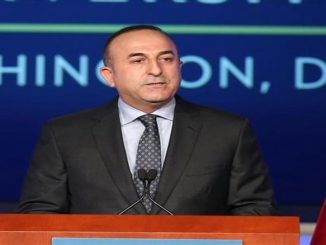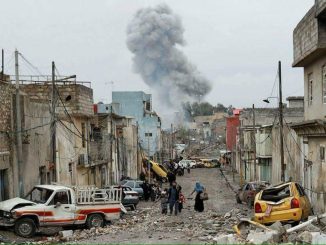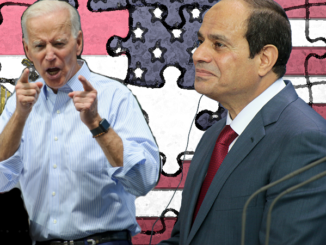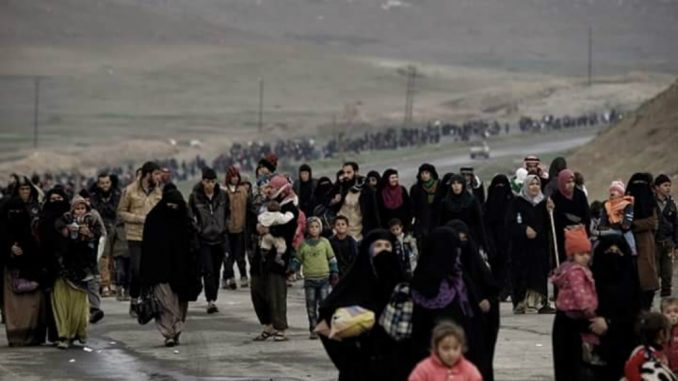
As the battle against Islamic State in western Mosul intensifies, tens of thousands have fled the violence to be accommodated in the already over-crowded camps. However, the UN expects the number of displaced people to raise even more and may reach 450.000.
At the height of its power two years ago, Islamic State ruled over millions of people in territory running from northern Syria through towns and villages along the Tigris and Euphrates river valleys to the outskirts of Baghdad in Iraq.
It was the mosque of Mosul where al-Baghdadi declared his Caliphate and named himself as the ruler of all Muslims from Mosul’s Great Mosque after his forces swept through northern Iraq in 2014.
However, ISIS’s territory is shrinking rapidly since last year as the US-led coalition, the Turkish-backed forces, and the Russian-backed Assad regime forces have fierce fights against its forces in both Syria and Iraq.
The United States is providing air and ground support to Iraqi and Kurdish forces trying to dislodge the hardline group from Mosul.
Iraqi forces captured the eastern side of Mosul in January after 100 days of fighting and launched their attack on the districts that lie west of the Tigris river on Feb. 19.
Islamic State militants who retreated across the Tigris river to western districts also regularly target civilian areas under government control in the east with mortars and grenades dropped from drones.
Several thousand militants, including many who traveled from Western countries to join up, are believed to be in Mosul among a remaining civilian population estimated at the start of the offensive at 750,000.
They are using mortars, sniper fire, booby traps and suicide car bombs to fight the offensive carried out by a 100,000-strong force made up of Iraqi armed forces, regional Kurdish peshmerga fighters and Iranian-trained Shi’ite paramilitary groups.
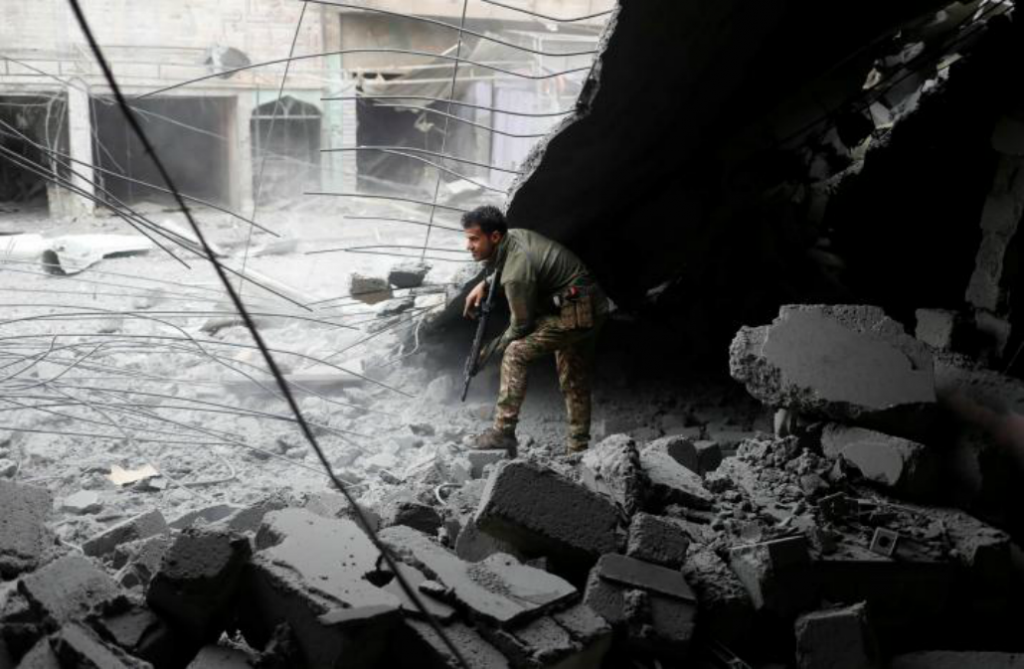
The catastrophe of Mosul
Residents of the western part of Mosul have launched a campaign using hashtag #MosulCatastrophe in order to attract the attention of the Iraqi government and global community to the horrific humanitarian situation in the city.
The activists uploaded a letter with an appeal to the Prime Minister of Iraq, Haider al-Abadi, and to the rest of the world, on their social media page called “Mosul Eye”.
This letter is an appeal to save the remaining residents of the western part of Mosul by providing medical aid, food and water to the suffering people.
The individuals behind this campaign are requesting the world to act fast and take urgent measures to free the city from the clutches of Daesh terrorists. The campaigners also appealed for the establishment of a provisional military government and to recognize the disastrous situation in the city.
“The situation in the city has reached a point where people are forced to eat garbage and waste because there is simply no normal food left. On Friday, three pregnant women died, 18 children died due to lack of water and nutrition. Dozens of civilians perished from shelling and clashes,” a paragraph from the letter reads.
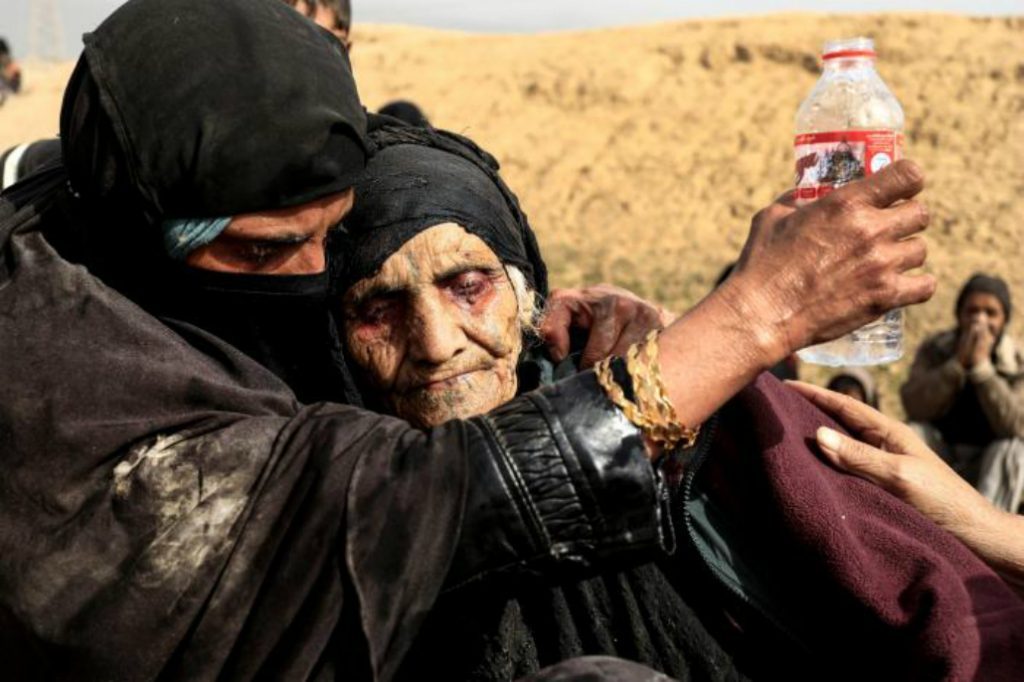
450.000 expected to be flee
The International Organisation for Migration (IOM) estimates, in a report released on Sunday, said 45,000 people have fled west Mosul since the push to seize it from ISIS began in February.
More than 17,000 people arrived from west Mosul on February 28 alone, while over 13,000 came on March 3, according to the IOM.
With this latest statics, the whole number of civilians displaced by the military operations reached more than 200.000.
However, up to 450,000 are expected to make their way to the camps, Lise Grande, humanitarian coordinator for the UN Assistance Mission in Iraq, said.
That number may still rise sharply. The United Nations last month warned that more than 400,00 people, more than half the remaining population in western Mosul, could be displaced. Fears of more chemical attacks are driving some people out.
On 4. March, a senior Iraqi government official publicly criticized UN-led efforts to aid those displaced by the west Mosul fighting, while the UN said that such assistance is the “top priority”.
“Unfortunately, there is a clear shortfall in the work of these [UN] organizations,” Jassem Mohammed al-Jaff, the minister of displacement and migration, said in a statement.
“Because the camps are operating at full capacity, the refugees are now being brought to the Kurdish regions here in northern Iraq,” a journalist said.
“There are buses behind us that have just arrived with more arrivals. We are talking about thousands and thousands of people.”
“Iraqi authorities say an average of 10,000 people are leaving every day,” she added. “Everyone we’ve spoken to here is telling us an unimaginable story.”
Fleeing in the night, No secure humanitarian corridors
Even when they are fleeing, death keeps hunting the Iraqi civilians as there are no safe humanitarian corridors out of the city and ISIS militants were shooting anyone who tries to leave.
Families attempting to flee usually do so in the middle of the night, said Grande. Still, it is a huge risk, and they often have to “run for their lives”. Civilians in the heart of the city depend solely on themselves to get their families to various gathering points at the frontlines. The Iraqi army usually takes over at the frontlines, transporting civilians to safety.
Civilians are often caught in the crossfire, and the chances of being shot while making the trip are extremely high, according to Grande. Those who miss this opportunity of being transported by the army often end up crossing the desert on foot before reaching one of the camps on the eastern side.
“There is no secure humanitarian corridor to get out of the neighborhoods that have been cleared, but even then there is still crossfire,” a journalist added.
“They [civilians] are having to make their way over barren land … just southwest of Mosul. We have seen people walking across land; people in wheelchairs, women with children exhausted and terrified, also leaving relatives behind because they are not sure if the route is secure.”
Others escaped across the frontline, waiting until they saw Iraqi forces in the distance and running towards them with white flags.
Along the way, they faced horrifying scenes.
“There were bodies in the street as we walked, children, pieces of bodies,” Safana, 23, told the AFP news agency, as she waited in a food distribution queue in the Hamam al-Alil camp.
The World Health Organization has set up multiple trauma stabilizing points (TSP), as close to the frontlines as possible, Grande said. There, wounded civilians are given emergency care before being transporting to the nearest hospital.
“What is striking about this crisis is that half of the casualties are civilians,” said Grande.”TSP areas have had to dramatically expand. We were not expecting this amount of casualties.”
Out of the entire IDP population at the refugee camps, 56 percent are children under 18.
There are about 1,000 unaccompanied children who have been separated from their families while attempting to flee since the offensive on western Mosul began, said Grande. “They [unaccompanied children] are the most vulnerable. They require the most intensive care we provide.”

